Clean Arctic Alliance Reacts to New Report Linking Co-Benefits of Action To Reverse Biodiversity Loss and Address Climate Crisis In Shipping Sector
Responding to the publication of new report, Navigating the Future: Bridging Shipping, Biodiversity, and Decarbonization, is the foundation of the 2030 Shipping Pact for People and Nature, the Clean Arctic Alliance provided the following comment:
“With an increase in planetary tipping points being reached, such as the loss of Arctic sea ice and the Greenland ice sheet, it is clear that the urgency to deal with the triple planetary crisis needs to be top of mind for all regulators and industry”, said Clean Arctic Alliance Lead Advisor Dr Sian Prior. “The 2030 Shipping Pact for People and Nature defines a way forward focusing on the co-benefits of mitigating the impacts on biodiversity and climate from global shipping and, comes at exactly the right time to support concrete actions which respond to this urgency.
“The Clean Arctic Alliance welcomes the 2030 Shipping Pact for People and Nature recommendations to reduce climate emissions from ships through improvements in the energy efficiency of vessels, slowing ships down, mandating more emission control areas which reduce air pollution including black carbon reductions, and banning the discharge of waste water from the use of scrubbers into the sea. Together all these measures have the potential to reduce climate emissions and underwater noise, as well as ramp down ocean and air pollution. Prioritizing measures in the shipping sector which focus on these co-benefits is what’s needed to give Arctic wildlife and ecosystems, and Indigenous people that depend on them a fighting chance.”

2030 SHIPPING PACT FOR PEOPLE AND NATURE (SPPaN) LAUNCHED AT COP28 – DECARBONIZING SHIPPING HAS A NATURE POSITIVE IMPACT ON MARINE BIODIVERSITY & ECOSYSTEMS
Contact: Andrew Dumbrille
Phone number: Canada – 613-290-2006
Email: [email protected]
Time Zone: Eastern Time (Ottawa)
Dubai, 8 December 2023 – Amidst the discussions at COP28 in Dubai, the pressing need to decarbonize the shipping sector takes center stage. In this context, a cross-cutting initiative, the “2030 Shipping Pact for People and Nature (SPPaN)” emerges to address the interconnected challenges of pollution, biodiversity loss, and the climate crisis and the potential co-benefits of shipping decarbonization for people and nature.
There has been increasing focus on the need – and opportunities – to decarbonize international shipping. However, a sustainable, resilient maritime industry needs to consider not only how to decarbonise, but also other environmental, social, and socio-economic impacts. In order to address the triple planetary threat of pollution, biodiversity loss, and the climate crisis we must ensure that the growing momentum to decarbonize is aligned with efforts to improve shipping’s overall impact on the ocean.
The new report, Navigating the Future: Bridging Shipping, Biodiversity, and Decarbonization, is the foundation of the 2030 SPPaN initiative. The report takes a close look at shipping’s short and long-term impact on ocean health, productivity, and biodiversity, highlighting the importance of a coordinated approach and links between actions to decarbonise and protect ocean health anchored in shipping practices.
‘Understanding, within the shipping sector, the intersections of climate and biodiversity is the primary purpose of the report. While outlining the urgency of tackling multiple planetary threats, the report creates a pathway for resilient solutions which benefit people and contribute to reversing biodiversity loss and addressing the climate emergency together.’ said Andrew Dumbrille, Co-Founder of Equal Routes and report co-author. ‘With the revision of the underwater radiated noise (URN) guidelines and the IMO’s GHG reduction targets this year, it’s a key time for the maritime sector to seize on the opportunity to feed two birds with one hand, so to speak. Building URN reduction targets into climate plans and strategies makes for an even stronger case to start implementing speed reduction and efficiency measures now.’
A central recommendation from the report is the framing of a new 2030 Shipping Pact For People and Nature (SPPaN), which outlines concrete measures to guide the maritime sector in assessing, reducing, and avoiding its negative impacts on marine biodiversity and climate. If quickly and comprehensively implemented, the Pact measures could contribute to reversing biodiversity loss and address the climate crisis.
‘Recognising that climate and biodiversity are interconnected is not only crucial to understanding how shipping operations currently impact the environment around them, but also essential to developing solutions for decarbonisation that also consider other ocean impacts and co-benefits’, said Andrew Stephens, Executive Director of the Sustainable Shipping Initiative.
Shipping activities have a significant impact on both climate and biodiversity, with the issue of underwater radiated noise (URN) being a prime example. URN is a form of acoustic pollution that can affect the behavior of marine mammals, severely impacting their health and long term survivability, and in turn impacting food security for people. However, reducing the global fleet speed can lead to a decrease in both underwater noise and risk of ship strikes, as well as yield a substantial decrease in greenhouse gas (GHG) emissions and increase the likelihood of meeting GHG targets. Mandating and encouraging speed reduction, along with increasing the efficiency of ships could contribute substantially in meeting the revised IMO GHG reduction targets of 30% by 2030 while also having significant positive biodiversity impacts.
2030 SPPaN also embeds foundational pillars to ensure the shipping sector is aligned with the UN Precautionary Approach, acknowledges Nature Based solutions to address the climate crisis, and Justice and Equity are at the center of building a transition that leaves no one behind.
‘People and the well being of communities has to be at the heart of addressing climate and biodiversity together in shipping. A paradigm shift has to occur which supports climate vulnerable Small Island Developing States (SIDS), Least Developed Countries (LDCs), and Indigenous Peoples, and reverses course on biodiversity loss. Utilization of Indigenous Knowledge needs to be a key component in this shift, which would be a significant contribution from the maritime community to implement the UN Declaration on the Rights of Indigenous Peoples’, said Lisa Qiluqqi Koperqualuk, President, Inuit Circumpolar Council – Canada.
“Shipping exists at the intersection of the triple planetary crisis – climate change, pollution and biodiversity loss – while commitments to improving shipping’s environmental performance exist, these efforts need to be harmonized. A sustainable, resilient maritime industry needs to consider not only how to decarbonise but also how to deal with a multitude of other environmental, social and socio-economic impacts. The Ocean Breakthroughs provide a rigorous, science-based framework through which to assess the impact of the maritime sector and to plan responsible action, I welcome the maritime industry’s efforts in joining us to create a sustainable, nature-positive future” said Her Excellency Razan Al Mubarak, UN Climate Change High Level Champion for COP28.
2030 SPPaN details multiple targets, best practices, and milestones that can be implemented as a basket of measures to address climate and biodiversity together. These include:
- Reducing ocean pollution from shipping by phasing out scrubber washwater discharges, treating effluent to the highest standard (including greywater), and eliminating discharges in Marine Protected Areas.
- Limiting the spread of invasive species by striving for 100% effectiveness of ballast water treatment systems, and making the IMO hull fouling guidelines mandatory.
- Ramping down air pollution with an ‘ECA (Emission Control Area) Everywhere’ policy, setting concrete targets of 50% reduction in air pollutants and 50% global reduction of black carbon emissions (99% near ice sheets and glaciers) by 2030.
- Focusing on marine protection through quadrupling the number of PSSAs (Particularly Sensitive Sea Areas), and setting high standards for shipping in Marine Protected Areas.
- Revamping the CII (Carbon Intensity Target) with a target of at least a yearly 8% efficiency improvement, which improves the energy efficiency of ships, swiftly bringing down fuel consumption and GHG emissions while reducing spill risks, black carbon emissions, and URN.
- Setting achievable 2030 targets for URN reduction of 50%, 25% fleet average speed reduction, and whale strike mortalities decreased by 80%.
- As has been done in the Arctic and Antarctic, banning HFO globally by 2030 to reduce spill risks and the use of hazardous bunker fuel for all global shipping.
Contact:
Dave Walsh, Communications Advisor, [email protected], +34 691 826 764
About the Clean Arctic Alliance
Made up of 22 not-for-profit organisations, the Clean Arctic Alliance campaigns to persuade governments to take action to protect the Arctic, its wildlife and its people.
Members include: The Altai Project, Alaska Wilderness League, Bellona, Clean Air Task Force, Green Transition Denmark, Ecology and Development Foundation ECODES, Environmental Investigation Agency, Friends of the Earth US, Global Choices, Green Global Future, Greenpeace, Iceland Nature Conservation Association, International Cryosphere Climate Initiative, Nature And Biodiversity Conservation Union, Ocean Conservancy, Pacific Environment, Seas At Risk, Surfrider Foundation Europe, Stand.Earth, Transport & Environment, WWF and Zero.
More more information visit https://www.cleanarctic.org/

